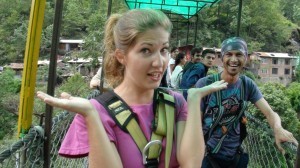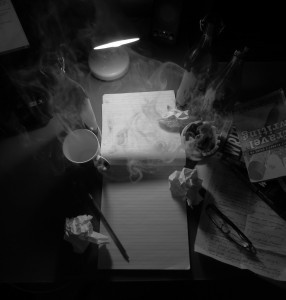Lisa Niver's Blog: We Said Go Travel, page 474
August 19, 2013
Myanmar: Bagan Day Six (video)
Watch: 30 Bagan Day Six, Myanmar (Burma)
For our sixth day of exploring in Bagan, Myanmar (Burma) we again traveled by bicycle.
Today we took our bikes to Nyuang U market. George got his shirt fixed and I bought a bag from Mee Mee Tin. We took in the river views at The Beach Bagan and saw the way to Mandalay by boat. On top of a temple overlooking Hilo Milo, we met Pico recently returned from the Peace Corps in Mongolia. George is a RPCV (returned peace corps volunteer from paraguay) We saw Pico again at “Be Kind to Animals” at lunch and met him and his friends at Shwe yar Su beer station for dinner. We also went to Ananda Phaya and Shwe Gu Gyi on our last day visiting temples in Bagan. October 16, 2012
Bagan is truly remarkable. I did have challenges with the bikes but I did it!
This movie is from our 28 days in Myanmar (Burma) from September 28, 2012 to October 26, 2012 and our year TRIP in South East Asia, see all the videos from our trip.
Our memoir, Traveling in Sin, is available at Amazon; it is a HOT NEW RELEASE!
Traveling in Sin: News from this Memoir's First week! from Lisa Niver Rajna
The post Myanmar: Bagan Day Six (video) appeared first on We Said Go Travel.
Canada: I Enjoy Myself Without My Ears
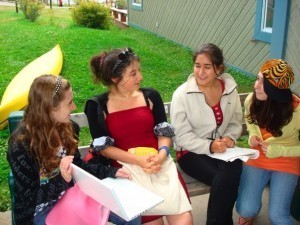 I hate Klezmer music. The whiny shriek of the clarinet sounds like a castrato who woke up to find a tarantula staring at him. The tunes all sound like a newly bar-mitzvahed boy went crazy on Clarinet or Trumpet Hero. The roughness of the syllables coming from the singer’s mouth reminds me of what I imagine pre-WWII Eastern Europe to be like, a place my grandparents left for a good reason.
I hate Klezmer music. The whiny shriek of the clarinet sounds like a castrato who woke up to find a tarantula staring at him. The tunes all sound like a newly bar-mitzvahed boy went crazy on Clarinet or Trumpet Hero. The roughness of the syllables coming from the singer’s mouth reminds me of what I imagine pre-WWII Eastern Europe to be like, a place my grandparents left for a good reason.
But from the ages of four to sixteen, I’ve spent my summers in the Quebecois Laurentian Mountains listening to the music I despise 24 hours a day at KlezKanada, a weeklong Yiddish cultural festival.
I love every second of every year at KlezKanada in Canada.
From the moment I first walked on to the gravel of the driveway that leads into the KlezKanada campsite, I was an instant celebrity. My father, born and raised in a Yiddish-speaking household, is the festival’s local celebrity. His witty and educational classes on Yiddish culture and language, as well as his hilarious MCing of the final, are the highlights of the attendees’ week. Whenever I was asked who my daddy was, the tone of the adult, who was usually trying to get me in trouble, changed from obnoxious and authoritative to awestruck and endearing.
By the second day of my first year at KlezKanada, I realized people weren’t buying me all the Coketails in the world because of my cute smile and funky hats. I was in a position that allowed me to act against the etiquette all the other children had to obey. And with my dad’s laid-back attitude, I could do whatever I wanted.
I loved to walk in on my father’s classes and tell the students how dumb they were because they couldn’t tell the difference between the letters gimel and zayn. I climbed onto the stage when my dad MCed and snatched the microphone away and began to test out my comedic material. I criticised the chef for serving anything but dessert. But everyone simply smiled at me and told me how cute I was.
Since the majority of people who attend KlezKanada annually are elderly, they don’t realize that I grow up a bit more every year. When I was sixteen, I was laughing with my friend during a concert. An old lady in front of us told my friend to “zip it!” but her eyes softened when she looked at me, and she proceeded to tell me never to hide my beautiful smile.
But my favourite part of KlezKanada was the interviews I conducted with my three best friends. Every day we would choose a new victim to interview. Sometimes it would be people we knew well, such as the teenagers whom we thought were so cool, other times it would be random people, such as the clarinettist that bore a striking resemblance to Chad Michael Murray. No matter who it was, I was notorious for asking the most inappropriate questions.
“How many girlfriends have you had?”
“A couple…”
“A couple means TWO! A fifteen-year-old only had TWO girlfriends! What a loser!”
I would continue to ask these types of questions, unknowingly taking on the role of the National Inquirer: Yiddishland Edition.
“Have you gained weight? I saw you eating a slice of cake last night—control yourself, man!”
“Did you put your eyeliner on in the dark today? You look like a raccoon.”
“Remember that time you asked Leah out and she rejected you?”
Every day, no matter how inappropriate the questions were, my three friends and I would publish our hour-long interviews in the daily newsletter. The newsletter was distributed to everyone’s dinner table; our interviews were the most popular page. We considered ourselves to be serious journalists.
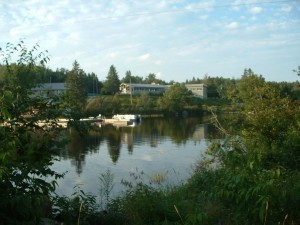 When we turned fourteen, we stopped doing our interviews because we decided these questions were no longer cute, but rude (the old people may not have remembered we were older, but we were mature enough to stop ourselves). Though I never interviewed anyone so brutally again, this experience has greatly influenced my life decisions.
When we turned fourteen, we stopped doing our interviews because we decided these questions were no longer cute, but rude (the old people may not have remembered we were older, but we were mature enough to stop ourselves). Though I never interviewed anyone so brutally again, this experience has greatly influenced my life decisions.
I always loved the interviews. I found out some incredibly personal things about people I had known since I was a baby. I was amazed how comfortable people felt in conversations with me. Inadvertently, these interviews helped me determine that I want to study journalism in university.
Whenever I write an article, obtaining interviews doesn’t scare me because I remember that if my four-year-old self could look someone straight in the eye and ask her about her romantic relationships, I can do the same at any age.
About the Author: Sabina Wex: I am a freshman at the University of King’s College studying journalism. Find me at Lil Hate Crime or on twitter @sabuwex
The post Canada: I Enjoy Myself Without My Ears appeared first on We Said Go Travel.
Where the World Meets
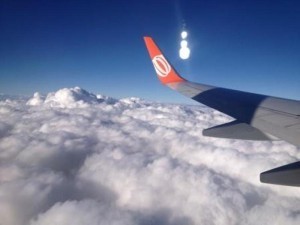 AMMAN. ALEXANDRIA. ATHENS. ANCHORAGE.
AMMAN. ALEXANDRIA. ATHENS. ANCHORAGE.
I hate to fly.
Take-offs are especially nerve racking for me.
Yet, airports are my sweet spot.
I drop my responsibilities, doubts and burdens at long-term parking, give a slight nod of acknowledgment to the sliding glass doors that part to welcome me, and breathe a contented sigh as I waltz into the terminal.
Standing off to one side for a moment, I absorb the racket, watching people dash off or saunter home. Families of five lugging sturdy Samsonites and minute wheeled versions of Sponge Bob and Dora the Explorer. Serious suits rushing to make a deal, backpackers bounding off on a solo adventure, couples escaping on a romantic getaway. It’s a travelers soup full of flavor and just a hint of a mystery ingredient.
I am free.
Free to wander. Free to dream. Free to eavesdrop on languages of which I can only guess the origin. Free to imagine what others are plotting.
That man striding towards check-in a floor-length tunic splashed with purple and gold? He is heading to a world peace convention in Jakarta. The gray haired lady waiting at gate 41? Visiting grand kids in Flagstaff, with a pit-stop in Vegas. That couple canoodling at the bar? A honeymoon for marriage number two in Barbados.
I am filled with the power of possibility.
I can be a writer. A small business owner. A full-time traveler. Maybe I’ll open a charming B&B on a beach somewhere and spend my evening chatting up guests over fruity cocktails and blazing sunsets. Perhaps I’ll take that three-month overland safari from Cairo to Cape Town.
I relish my final hours on land, where I pop in for a ten-minute massage, then grab a snack that is certain to be better than whatever they are serving in the air. Oh, and the magazines I will soon crack open! Fashion, politics, gossip, economy.
But the real pleasure rests in the final hour before boarding. I curl up in a quiet corner at some unused gate, juice up my electronics, settle in with my magazines… and watch the departure board’s continuous scrawl.
MAASTRICHT. MUSGRAVE. MILWAUKEE. MADRID.
Famous cities I remember fondly. Capitals I still long to discover. Names I scrunch my forehead at as I try to will their locations on the map into memory. Will I listen to melodies in Maastrict? Take in flamenco in Madrid? Draw a draft of Pabst or Miller in Milwaukee? And where in the world is Musgrave? Why in Western Australia of course!
I think back to my last flight, when I soared above clouds so blindingly white and inflated they appeared to be solid… until a break in that bright, powdery mass revealed a new discovery below. Be it Akron or Aswan, both are equally filled with hazard and hope, opportunity and risk. A junction between the places I’ve absorbed into my consciousness and those still on the waiting list.
Soon I will be strapped into my seat and on my way to my own destination, exhilarating and exclusive all on its own. But until then, I can fantasize about the names climbing their way up the screen.
ZANZIBAR. ZURICH. ZACATECAS. ZLIN.
The possibilities are endless.
About the Author: I’m Fran, a New Yorker who recently left the Big Apple to take a bite out of a more balanced life. I left behind a 17-year career as a TV news producer to quench my thirst for travel, food and writing. I currently spend most of the year teaching and writing in Brazil and the rest discovering different cultures and lands. Find me on Facebook.
The post Where the World Meets appeared first on We Said Go Travel.
Kuala Lumpur, Malaysia: Traveler Meetup Tomorrow
 Kuala Lumpur, Malaysia:
Kuala Lumpur, Malaysia:Meet up with local travel bloggers and anyone else who is passing through town! We’ll eat at the best banana leaf in town, Nirwana Cafe in Bangsar.
8 o’clock sharp! See you there!
43 Jalan Telawi 3, 59100 Kuala Lumpur, Bangsar, Malaysia
RSVP on Facebook and for more details.
More information about the Festival of the Pacific Events: Click here.
Traveling In Sin: A True Tale of Transformation Through Love and Travel from Lisa Niver Rajna
Festival of the Pacific is a celebration of travel and transformation hosted by We Said Go Travel and the University of Pennsylvania. The theme, “Living Without Regret: Travel, Love and Success: Make your Dreams a Reality” will be presented in a series of live talks held in Kuala Lumpur, Manila, Guam, Oahu and Los Angeles.
Join Penn graduate Lisa Niver Rajna (C’89) and her husband George Rajna – founders of We Said Go Travel – for an inside look at long-term exotic international travel across Asia. They will share their travel expertise, read an excerpt from their new memoir, “Traveling in Sin,” and provide information about We Said Go Travel’s writing contest, and upcoming community. The Rajnas will also reveal why Myanmar holds a special place in their hearts, and why Lisa states: “The Shwedagon Pagoda is my favorite place on the planet.” Lisa and George have been living abroad since July 2012. Following the live talks, join them for a webinar on October 23, 2013 focusing on their journey in Myanmar.
We would like to recognize the Festival of the Pacific Founding Partners: LACOT, Dave’s Travel Corner, Wandering Educators, Richard Bangs Quest for Adventure, and NokiaConnects.
The post Kuala Lumpur, Malaysia: Traveler Meetup Tomorrow appeared first on We Said Go Travel.
August 18, 2013
Russia: Home away from Home.
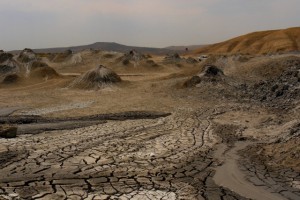 I am interested in this interaction between the place we are in and the development of our minds. The interplay of space and mind creates place when I think about my sense of place, it’s hard for me to pin it down.
I am interested in this interaction between the place we are in and the development of our minds. The interplay of space and mind creates place when I think about my sense of place, it’s hard for me to pin it down.
Let’s start with my hometown. I was born and raised in Agbor Delta state Nigeria. I’ve never wished I were from any where else. People wish they hailed from somewhere else because they’re unhappy with their current place, or their past. They imagine a life that began in a distant metropolis, with a different house on a different street, because wherever they are leaves them unfulfilled.
I remain attached to my hometown, “because it has made me who I am”. However, I find that my sense of place expands far beyond my home in Delta state. Upon examining the settings and situations that comfort me, I find that my sense of place connects intrinsically with my memory.
Whether the facilitator’s ‘place’ is a stage, a group room, a retreat, a gym, a maze or a canvas we use place as a lot more than a setting to create the right ambience for our work. Place can act as healer and as guide as the emerging soul begins the tasks of creating their own world and acting in it. Heron sees these processes as essential activities of the creative psychic states and it is familiar territory for Development.
One of my most vivid childhood memories is a trip to Russia with my mother. I remember sitting in my car seat and gazing out the rear window in amusement of Russians great shaped towers, the maiden tower located in the south east part of icheri sheher; this unique monument of Azerbaijan. A place that was seriously damaged by Russian Naval bombardment in the 18 century and the Moscow night light.
As a ten-year old, in my head Russia was a place to behold. Sometimes the memories of “our earliest life experiences” are “a sensation as sweet as seeing ourselves in our dreams. These memories are ones we could not have formed ourselves in our dreams and quite possibly did not occur. Yet they are often the strongest and most lasting.
If I 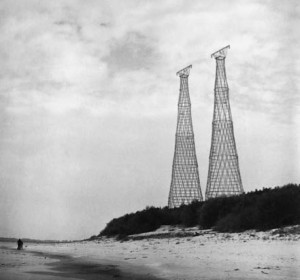 have the opportunity to travel to Russia again, I will look up at those towers and say welcome home. As I said earlier, there are some places in my hometown where I don’t feel any sense of place at all the value of local communities for older people’s quality of life is widely recognized how friends and community affected our trip we had friends of close proximity, a view that was often expressed in terms of the quality of friendship with different ethnic groups.
have the opportunity to travel to Russia again, I will look up at those towers and say welcome home. As I said earlier, there are some places in my hometown where I don’t feel any sense of place at all the value of local communities for older people’s quality of life is widely recognized how friends and community affected our trip we had friends of close proximity, a view that was often expressed in terms of the quality of friendship with different ethnic groups.
Where I stayed for the trip I see so many people passing my way, you know and they say ‘Hello, hello’, that’s fine ‘Good morning, nice weather’ or ‘It’s not very nice’, and that’s it. I would like to go and visit them but they want to be on their own, like, maybe due to cultural reasons. So, this is the reason why I want to live within the Community.
Connecting to my sense of place from my trip to Russia as a child, which resided in my imagination, allowed me to chase away some of my doubt and pain, and ultimately helped me reclaim my sense of self.This sense of identity is perhaps what makes one’s sense of place so important. Foregoing a sense of place was more important than accepting an identity I didn’t want to. I remembered the towering monuments, the streets that always appear dry, the taste of a pie and the interesting people around i felt a sense of longing, as if I have left a part of myself there.
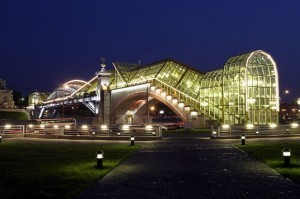 The definition of my sense of place, it’s much more than a city tower bell or dot on a map. My “place” is place is in my memory, neither is it limited to a geographic location. It resides in the sight of those historic places and towers in a parallel universe like Russia just like a boy playing at the bank of a sea-shore.
The definition of my sense of place, it’s much more than a city tower bell or dot on a map. My “place” is place is in my memory, neither is it limited to a geographic location. It resides in the sight of those historic places and towers in a parallel universe like Russia just like a boy playing at the bank of a sea-shore.
About the Author: I am Matthew Monyem a 21year old simple, gentle, loving, passionate and intelligent young man who loves the beautiful things of life. Find me on Facebook.
The post Russia: Home away from Home. appeared first on We Said Go Travel.
Finding Hope and Hospitality in the West Nile
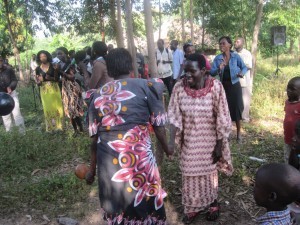 A Spiritual journey through West Nile, where hope and hospitality is in ready supply
A Spiritual journey through West Nile, where hope and hospitality is in ready supply
New to me is the picturesque St. Emmanuel’s Cathedral. The last time I was in Arua (Christmas holidays of 2000), grandpa had retired from active church ministry he served in the former sanctuary; a dilapidated temple reminiscent of the days of the law–permanent cement pews on either side of the aisle built to outlast even the gospel itself, a relic podium with legs thinned by termites (ojuruko), steadfast by grace than wood. In the holiday season, this edifice serves the purpose of Sunday school.
In six days, myself with friends from Kampala will venture like missionaries preaching the gospel upon request by Bishop Joel Obetia with the support of vigilant youth from Mvurra county: “Congo”, “Sudan”, through to “Kenya” and then finally “Zambia/Central” zone. These are the sub-zones which unify Mvurra into one.
They were named so by former president Idi Amin; being allies to Uganda (read Amin) during a time of political turmoil and in return, they earned an eternal place in the Nilotic folklore.
Every day ushers ribbons of surprises. One night as we prepared to rest at the residential teacher’s quarters, a three minute’s walk from the quaint sanctuary, a friend carelessly sweeps a trail of red ants (eyekeye), we had a quiet good laugh.
In Sudan zone, we come across teenage boys digging red earth of what would be a pit latrine. After brief introductions they are willing to listen to us–a distant opposite from the language of transaction in the cosmopolitan, “Nfuniramu wa?” (What do i gain from this?)
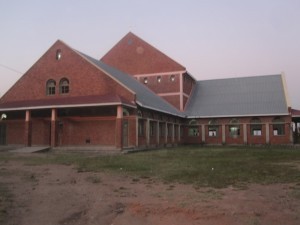 That teenage boys would sit and listen to us without being coerced by a guardian is humbling to say the least. It also reminds me of that portion of scripture in Mathew 19:14, “but Jesus said, “Let the little children come to me and do not hinder them, for to such belongs the kingdom of heaven.” (ESV)
That teenage boys would sit and listen to us without being coerced by a guardian is humbling to say the least. It also reminds me of that portion of scripture in Mathew 19:14, “but Jesus said, “Let the little children come to me and do not hinder them, for to such belongs the kingdom of heaven.” (ESV)
Each day comes with a teasing delight. I notice that village chiefs went out of their way to prepare special dishes to minister to our dietary needs. The meals were simple but served with gracious hearts; each meal comprised millet bread, enyasa (E-nyah-Sir). There is a strictly creamish-brown cassava bread however we ate bread consisting of both ground millet and cassava flour served with varying dishes; of salty dried mud fish otherwise called angara (Anga-rah) replete with protein cum bones.
The joke is that the young folk first observe an elder eating this mouth-watering dish. He dips a lump of enyasa into a bowl of soup, gathers a portion of the fish and combines the two before they go into his mouth–he does not chew but rather sucks the contents and sieves the bones of fish through one side of his mouth and finally spits them to the floor. And no, you do not use a fork, does not matter whether you are at home or in a fancy restaurant.
We also ate greens served with ground nut paste, osubi (O-suu.Bi) a distant cousin of malakwang (staple for the Acholi) another Nilotic majority from the North. Humid as it was (usually the Ember months); we drank tea which serves as a cooling hydrant. We also had ripe mangoes and succulent oranges for dessert.
On New Year’s Eve/New Years Day, the compound of St. Emmanuel’s Cathedral serves as a hub of merriment. Among the crowd is the bishop; several men of collar, members of parliament, pubescent youth, wandering children all packed to the rafters under three converging tents. Observing this activity is a handful of police personnel.
Ten minutes to midnight, all lights are turned off as candles are lit. That moment, people join together across denominations to be a voice—more than that to be a voice to the voiceless to petition the government of heaven to intervene in the affairs of earth, in the sphere of government, education, media, family, and finally business. That God would raise leaders of distinction to be a beacon for our next generation. It is called unity and it is what binds us.
At midnight, fierce sounds rapture from the top of metallic containers into the skies flitting into different hues and lights. Alas, fireworks litter the skies; revellers throng the green whistling and dancing to joyful noises bellowing from the musical instruments. Some folks hug each other; others use their phones to text and call distant friends.
It didn’t occur to me at the time that i had spent two years in the same country.
There is a hope which exists today. Amid the travails facing Africa’s generation is a hope to cope. That momentary glint ignites the belief of a today which is better than yesterday and it rests in this young generation but the responsibility for my country is to invest in them now.
About the Author: Emmanuel S. Anyole blogs at Sebeenah; he has published book reviews and pieces on social commentary of African life and the ever growing paradox of being a Ugandan. A regular contributor to literary websites, Sebi lives in Uganda. Find him on Facebook and Twitter.
The post Finding Hope and Hospitality in the West Nile appeared first on We Said Go Travel.
Italy: Big Kid Fun
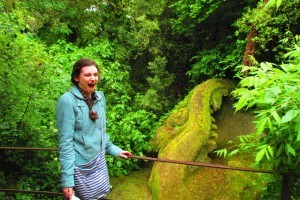 I hate cats. In fact, cats and I have a mutual hatred for each other that works out well. I pretend I don’t see cats, they pretend they don’t see me. In a twisted way, we’re sort of perfect for each other. But despite our differences, for some reason, when I went to Rome, Italy, I was immediately drawn to what appeared to be one of the strangest attractions I have ever seen: feral cats.
I hate cats. In fact, cats and I have a mutual hatred for each other that works out well. I pretend I don’t see cats, they pretend they don’t see me. In a twisted way, we’re sort of perfect for each other. But despite our differences, for some reason, when I went to Rome, Italy, I was immediately drawn to what appeared to be one of the strangest attractions I have ever seen: feral cats.
There is literally an area in Rome in which the cats seemed to have taken over an ancient Roman temple. Rather than kicking the kitties out of the precious ruins, somebody decided to block the area off and open it up as a tourist attraction: the Cats of Rome. It is even complete with a downstairs viewing area and a gift shop. Suppose you find a cat that you particularly fancy; well, you can go ahead and purchase that cat as a fluffy souvenir.
While the display of feral cats as a tourist attraction certainly baffled me, there were other things about Italy that had puzzled me even more. For one, they eat dessert for breakfast. While I certainly did not disagree with this, the first morning in Amelia when my host mother set out a piece of last night’s cake before me and smiled encouragingly I thought that maybe she was allowing me to indulge a little as a sort of vacation treat. However, the next morning when it was two pieces of last night’s tart, and then the following morning I was given some cookies smothered in jam, I began to understand that it was just the custom in Italy. They eat dessert for breakfast. It was as if I had arrived in a beautifully twisted paradise. Why shouldn’t we indulge first thing in the morning?
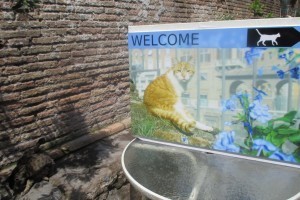 And as if that wasn’t twisted enough, the Italian concept of time was a completely separate language that I still don’t quite understand. Not only do most stores take two-hour breaks during lunchtime and then return to work at their leisure, but each day at the Italian language school I attended we would take a fifteen minute coffee break twice a day that would somehow find a way to stretch into an hour-long relaxing outing at a local coffee bar.
And as if that wasn’t twisted enough, the Italian concept of time was a completely separate language that I still don’t quite understand. Not only do most stores take two-hour breaks during lunchtime and then return to work at their leisure, but each day at the Italian language school I attended we would take a fifteen minute coffee break twice a day that would somehow find a way to stretch into an hour-long relaxing outing at a local coffee bar.
When we were scheduled to start class at nine, it almost always meant we would begin at 9:15. If we were supposed to attend a dinner at eight, it meant that we would leave for dinner at eight and we would most likely be eating at nine. Not to mention, that any meal at a restaurant was a two-hour affair no matter how much or how little food you ordered.
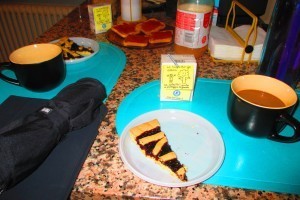 Italy seemed to have its own guidelines. Somehow it was naturally independent of the basic rules and structures that held back other countries. Like the feral cats that took over the ancient ruins, Italy did what it wanted with an alluring flair. For one, the drinking age doesn’t exist. Anyone and everyone is welcome to share in the joy of a nice glass of wine or a strong blast of limoncello. And those pesky stop signs? Completely optional. As long as the road is clear, you can most certainly blast right through them. Your dogs don’t need leashes in Italy, either, and they can poop right on the sidewalk. No one needs to pick it up. If you don’t consume at least three courses of carb-loaded food at dinner and dessert, you’re doing something wrong. But, amongst all of these Italian lessons in life, I learned that feral cats are creatures to be admired and displayed, that time is not something that can imprison us and most importantly, that dessert is for breakfast.
Italy seemed to have its own guidelines. Somehow it was naturally independent of the basic rules and structures that held back other countries. Like the feral cats that took over the ancient ruins, Italy did what it wanted with an alluring flair. For one, the drinking age doesn’t exist. Anyone and everyone is welcome to share in the joy of a nice glass of wine or a strong blast of limoncello. And those pesky stop signs? Completely optional. As long as the road is clear, you can most certainly blast right through them. Your dogs don’t need leashes in Italy, either, and they can poop right on the sidewalk. No one needs to pick it up. If you don’t consume at least three courses of carb-loaded food at dinner and dessert, you’re doing something wrong. But, amongst all of these Italian lessons in life, I learned that feral cats are creatures to be admired and displayed, that time is not something that can imprison us and most importantly, that dessert is for breakfast.
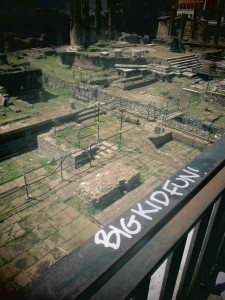 As I stood that day admiring the odd, but amusing display of the Gati di Roma, a couple words from a graffiti artist caught my eye. “Big Kid Fun.” The phrase seemed to stick in my head with the same invigorating enthusiasm I had felt ever since I began breaking all the rules in Italy. It was not adult fun, it was big kid fun. Italy brought out the essence of childhood in me and the freedom to give in to the fun big kid that exists in all of us. It taught me that life is not bound by anything as long as we don’t allow it to be. As I left the wild felines stretching and sleeping in between the columns of the ruins they claimed for their own, I began to think that maybe cats aren’t so bad.
As I stood that day admiring the odd, but amusing display of the Gati di Roma, a couple words from a graffiti artist caught my eye. “Big Kid Fun.” The phrase seemed to stick in my head with the same invigorating enthusiasm I had felt ever since I began breaking all the rules in Italy. It was not adult fun, it was big kid fun. Italy brought out the essence of childhood in me and the freedom to give in to the fun big kid that exists in all of us. It taught me that life is not bound by anything as long as we don’t allow it to be. As I left the wild felines stretching and sleeping in between the columns of the ruins they claimed for their own, I began to think that maybe cats aren’t so bad.
About the Author: Shannon Fitzgerald is a rising senior at Allegheny College pursuing a career in the literary field. She is from a small, snowy town south of Buffalo and just a short drive away from Niagara Falls. Traveling has been an important part of her life since her parents first took her on a trip to Disney World at the age of four.
The post Italy: Big Kid Fun appeared first on We Said Go Travel.
August 17, 2013
Nepal: The Big Jump
Though it comes in useful when making decisions such as whether or not to put your hand on a hot stove, pet the rabid dog or step into on-coming traffic, it can often be debilitating. Fear can prevent us from taking risks that could significantly benefit our lives or the lives of others. It can stop us from asking out our potential spouse, going for that dream job or standing up for what we believe in. Unnecessary fear can be a limitation that hampers our freedom to go after what we really want.
For me, bungee jumping was never even a consideration.
Aside from the fact I really had no interest in the activity, my mother had firmly ingrained this “bungee jumping is dangerous and equals sudden death” mentality into my head since I was a child. That stuff runs deep.
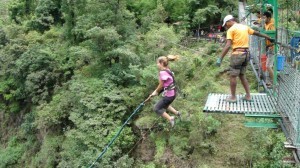 But the minute I landed in Kathmandu, Nepal and saw the bungee jumping advertisements, something changed. My birthday was coming up, and somehow that firmly ingrained idea of “never” changed into “wouldn’t it be crazy if…” While 28 has never been considered a milestone, this birthday was coming near the end of my once-in-a-lifetime epic journey throughout Asia, and I knew I wanted it to be special.
But the minute I landed in Kathmandu, Nepal and saw the bungee jumping advertisements, something changed. My birthday was coming up, and somehow that firmly ingrained idea of “never” changed into “wouldn’t it be crazy if…” While 28 has never been considered a milestone, this birthday was coming near the end of my once-in-a-lifetime epic journey throughout Asia, and I knew I wanted it to be special.
When I met up with my friend Naren and semi-jokingly put forth the idea, his very enthusiastic “Yes, we’re doing it!” scared the daylights out of me. Though my reply was “Let me think about it,” my sharply rising anxiety levels told me the decision had already been made: I was going to jump.
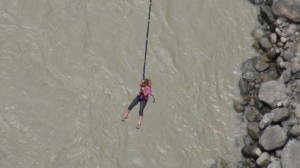 For days, my fake indecisive self was stressing out. I suddenly found the need shop constantly, eat everything (how many momos are too many?) and sleep was fleeting. I didn’t know how I was going to pull this off.
For days, my fake indecisive self was stressing out. I suddenly found the need shop constantly, eat everything (how many momos are too many?) and sleep was fleeting. I didn’t know how I was going to pull this off.
And then Naren offered me a Hindi saying I’ll never forget: “Darr Ke Aage, Jeet Hai,” – Beyond Fear, Lies Victory.
These simple words struck a chord with me. What exactly was I afraid of? Were these fears justified? Did I really think I would get injured (or worse) bungee jumping?
The answer was no. I was afraid of the intensity of an adrenaline rush I had never experienced before, and that was not a good enough reason to back out.
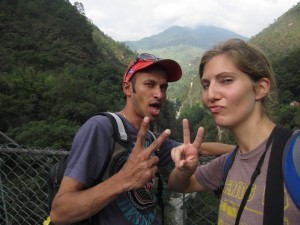 I decided that I could control my reaction to how this jump turned out and whether or not it would be a positive or negative experience. If I chickened out, I not only lost $100 but my pride. I was going to own this jump. Like a boss.
I decided that I could control my reaction to how this jump turned out and whether or not it would be a positive or negative experience. If I chickened out, I not only lost $100 but my pride. I was going to own this jump. Like a boss.
When we reached the mountains, I think everyone in the bus had a moment of “Oh crap, are we actually doing this?” Then it was the briefing: stand here, hold this, don’t look down…
Then the moment of truth: time to walk the plank. To my surprise, the line moved along quickly, and I was running out of chicken-out moments. Harness on, inches from the jumping platform, I asked the jump master to give me a second to catch my bearings. He smiled and said, “Don’t worry, you get three.” Very funny, that one.
As Naren waited a few feet behind me, anticipating a highly-dramatic, song-and-dance freak out routine, I chanted to myself: “Darr Ke Aage, Jeet Hai.” My mind went suddenly clear. I felt the pull of the canyon line, looked ahead to the mountains and did the only action required of me: I jumped.
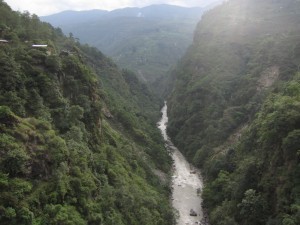 Like a second before, my mind went blank, I didn’t even scream. Instead, I felt my eyes get very large as I took in the blurry mountains, trees and river that were rushing by all around me. For seven seconds, I was weightless, and though it was by far the biggest adventure rush I had ever had, it wasn’t nearly as scary as I thought it would be. And when I felt the harness catch (yay, I survived!), the leisurely swing through the canyon provided one of the most beautiful sights I’ve ever seen.
Like a second before, my mind went blank, I didn’t even scream. Instead, I felt my eyes get very large as I took in the blurry mountains, trees and river that were rushing by all around me. For seven seconds, I was weightless, and though it was by far the biggest adventure rush I had ever had, it wasn’t nearly as scary as I thought it would be. And when I felt the harness catch (yay, I survived!), the leisurely swing through the canyon provided one of the most beautiful sights I’ve ever seen.
But more incredible and unexpected than anything was the immense sense of satisfaction I felt afterward. I had faced my fears and won. And the feeling was truly victorious.
But more than victorious, the feeling was truly freeing. I had literally jumped into the unknown and walked away with a courage and strength that would last far longer than my seven-second free fall. I walked away with a freedom to overcome my fears, and that is a feeling that will last a lifetime.
About the Author: Erica Hobbs is a traveler, writer and journalist with a passion for adventure. After graduating from the University of Michigan in 2006, she worked in print, digital and broadcast journalism before moving to Malaysia to take a public relations job. She currently works a freelance journalist in Michigan and continues to seek adventures within her home state.
The post Nepal: The Big Jump appeared first on We Said Go Travel.
Travel is the Traveler
The guidebooks warn about this treacherous, hardscrabble path. “The travel-writing trail is long,” one says, solemnly. “It can be extremely demanding and daunting…lonely, exhausting, and depressing.” But here, I’m undaunted and uninhibited, quickened by a private fire, and the warnings only fan my ardor as I survey the vexing terrain.
The path to My Notepad traverses the flatland of the Writing Desk, stretching out to the north of an amorphous formation of laundry. The Library, a mountainous ridge of musty, dog-eared peaks rising and falling like a cardiogram, plummets steeply into a valley formed by a friend borrowing “Road to Oxiana.” There are ruins and curios abandoned by the area’s nomadic people scattered around this fertile plain: crinkled, incomprehensible road maps; guided-tour brochures; a mahogany backgammon board, inlaid with pearl, Turkish in origin; a Nepalese gurkha with a dragon etched into its blade; a mosaic of blue, pocket-sized, hardcover notebooks where half-deciphered hieroglyphics have been scrawled.
I linger in the ruins inhaling their memories, then head for the Wine Bottles densely foresting the northwest. The transparent sea green of their print-smudged trunks indicates the sap – a cheap, saccharine Shiraz thought by the locals to induce creativity, courage, and charm – has already been tapped by indigenous persons.
Discouraged, I press onward. Sweat stings my eyes; dryness parches my throat. The air is thick with acrid haze from The Ashtray’s nightly fires. And there, in a clearing, abutted by Coffee Mugs, lies the Indonesian-made, Sinar Legal Pad – it’s sulfur-yellow surface unfolding before me with ominous invitation.
Nearby, blunted pencil stubs, gnawed by teeth marks, rest on their sides like derelict ships. Strange flora surround the shores: the curling, withered petals suggest a common species of Scriptus Excrementae, or “crumpled waste papers.” According to regional mythology, these poisonous flowers bloom after failed attempts to cross the pad’s surface. The muscles in my gut tighten; my mind seems a desiccated husk. Maybe a day trip to The Bed for a nap would be better?
No, I mustn’t. Again, I consult the guidebooks – “The Art & Craft of Writing,” “Writing for Story,” “The Guide to Travel Writing” – hoping to glean a spark of courage from trailblazers. It’s growing late. I came to challenge The Notepad and its unpredictable surface – sometimes sluggish as wet concrete, sometimes unwieldy as torrential rapids – but I haven’t yet dared to venture out. A circle of light falls from a 120-watt General Electric© moon on the beckoning blankness. Drums pound demonically; a voice yelps like a wild animal. The rhythms of a local tribe, The Rolling Stones, explode from the ancient chambers of a Panasonic tower. My blood thrums excitedly. I clutch my vessel – a #2 HB Faber-Cassel – in a frenzied, reckless fit and dash to the right, directly into the current.
It’s hard-going at first: I slip on spelling; fumble with tenses. But soon I’m on “a Hearts & Tears motorcycle zipping through the winding, badly-paved roads of Sarangkot in the Pokhara Valley, on my way to paraglide through gauzy, golden light with a thermal-seeking Egyptian vulture recovered from captivity…”
I lose direction in a thicket of purple prose, so I head for the Hiber Hotel bar in Addis Ababa where “slender, tired-eyed waitresses serve steaming plates of spicy lega tibs and overpriced old fashioneds as we fidget at our table under a swinging blue light, waiting for Impression to emerge and, after halfhearted apologies, launch into a nervous rendition of “Autumn Leaves”…”
The neighboring tribe from Porlock bellows a warning in their vulgar, unprintable dialect to keep the music down. I falter slightly; my concentration slips. But I deftly stabilize and breeze into Trieste, to the “Caffe degli Specchi in the Piazza dell’Unita where, while sipping an aromatic cup of Illy (“Un po’ di zucchero, per favore. Grazie!”), two well-dressed men discussing politics in Triestini cover their heads with today’s edition of Il Piccolo and duck, cursing, under the awning to escape a sudden shower that’s arrived from over the Slovenian karst…”
I fall back exhausted, breathless, exhilarated from the uncharted, furious passage. I’ll have to remake the journey in the morning so I survey my path carefully, now approvingly, now regrettably.
I recognize Fernando, an inhabitant of the northern tomes, alone in the now-quiet night. He calls to me. Diaphanous light pools in his circular lenses; he sips coffee through an elegant triangular mustache.
“Travel?” Senhor Pessoa says, “One only need exist to travel.”
“If you imagine, you see it.”
He nods. “What more do I do when I travel? Only extreme poverty of the imagination justifies having to travel to feel. It is in us that the scenery is scenic.”
I smile, dreaming over Beijings and Madrids unspooling upon My Notepad tomorrow.
______________
About the Author: Adrian DeVuono is an award-winning scholar of comparative world literatures, an amateur boxer, and a new member of the travel, and travel-writing, community. Adrian recently completed his Master’s thesis on censorship in American Literature and is currently a student of MatadorU network and on Facebook.
The post Travel is the Traveler appeared first on We Said Go Travel.
Myanmar: George’s article on About.com
Thank you to Greg Rodgers and the Asia Travel section of About.com for publishing George’s article:
Top 5 Places to Go in Myanmar
1. Bagan Temples:
Bagan, a vast, spectacular desert dotted with stunning varied temples can be toured by bike or vehicle. This extravagant temple complex is the highlight of a trip to Myanmar and should not to be missed.
From the 11th to the 13th centuries, over 10,000 Buddhist temples, pagodas, and monasteries were constructed within Bagan; over 2,200 temples still survive today and comprise the vast area. Amidst the amazing temples, climbing pagodas to view the immense stupa-dotted plain is especially enjoyable during sunset. This archaeological zone abutting the Ayeyarwady River began in 1047 and occupies over 25 square miles.
Read the full article at About.com
See George’s Author Page on About.com
Buy our memoir, Traveling in Sin, at Amazon; it is a HOT NEW RELEASE!
The post Myanmar: George’s article on About.com appeared first on We Said Go Travel.
We Said Go Travel
We Said Go Travel is a global community of over sixteen hundred writers with articles from every continent.
Stories are shared with photos and video from a perspective of the transformative power of travel. We Said Go Travel has hosted live and online events as well as travel writing contests around the world. ...more
- Lisa Niver's profile
- 57 followers


